CELEBRATING A HALF-CENTURY OF RESEARCH



FIU is Miami’s only Carnegie-designated R1 very high research activity public university.
TOP 15 Most Innovative Public Universities (U.S. News & World Report)
7
TOP 10 in the past decade among public R1 universities for research expenditure growth
5
1 4 2
FIU conducts research in every ocean and on every continent.

3
$282 million Research Expenditures FY 2021-2022
6
$1 billion Research Expenditures Last Five Years
TOP 20 Public Universities for U.S. Utility Patents (Intellectual Property Owners Association)
FIU is leading Operation Pangolin, an international collaboration to save the world’s most trafficked wild mammal, which is globally endangered. Little is known of the trafficking supply chains that move at least 250,000 pangolins – the world’s only scaly mammal – out of African and Asian forests to consumers in China, Vietnam and elsewhere every year. FIU researchers are helping develop solutions to the crisis.

Florida International University opened its doors to students 50 years ago, in 1972. This year, as university leaders discussed how best to celebrate this historic milestone, it became clear that any efforts must include a tip of the hat to the university’s remarkable research program. Driven by the intellect and curiosity of our researchers and students, the success and sustained growth of FIU’s research program are key factors in the university’s Top 100 ranking among public universities.
It seemed appropriate, then, that we produce a piece – 50 facts about FIU research – in honor of our 50th anniversary. Rather than a look back, this piece was intentionally designed to look forward. For those of you who are not familiar with FIU’s research program, we hope these pages pique your interest to learn more about the people and projects behind our robust research program. To our colleagues who are already familiar with our research program, we hope this content reminds you of the depth and breadth of our innovation and discovery. This publication was not designed to be a comprehensive report but rather a glimpse into our areas of research excellence.
In April, we will publish our new research magazine. The annual publication will include in-depth reporting about the people and research that have helped drive FIU’s rise in the rankings of America’s public institutions of higher education. If you want to make sure you receive a copy, please send an email to researchmag@fiu.edu with your name, organization and mailing address.
I hope you enjoy this publication, and I encourage you to visit research.fiu.edu to learn more about FIU’s research and our great faculty and students.
Thank you,
 Andrés G. Gil ’86 Senior Vice President, Research and Economic Development Dean, University Graduate School Professor, Robert Stempel College of Public Health & Social Work
Andrés G. Gil ’86 Senior Vice President, Research and Economic Development Dean, University Graduate School Professor, Robert Stempel College of Public Health & Social Work
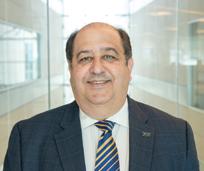 An FIU biologist sets up a 360-degree camera off the coast of Bimini to film hammerheads as part of long-standing research on marine predators. Much of the work of marine ecologist Mike Heithaus, executive dean of the College of Arts, Sciences & Education, and his colleagues focuses on the ecological importance of sharks and other large marine species.
An FIU biologist sets up a 360-degree camera off the coast of Bimini to film hammerheads as part of long-standing research on marine predators. Much of the work of marine ecologist Mike Heithaus, executive dean of the College of Arts, Sciences & Education, and his colleagues focuses on the ecological importance of sharks and other large marine species.
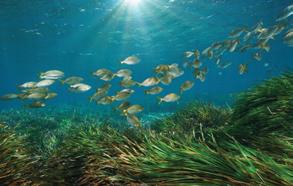

8 9
One of the world’s foremost experts on seagrass ecosystems, James Fourqurean is a lead scientist in the International Blue Carbon Working Group, focused on carbon captured by oceans and coastal ecosystems. Fourqurean helped create a global partnership promoting the development of international conservation solutions.
Researcher Elizabeth Anderson leads work across the Amazon Basin to understand the dynamics of river flow and the human dependencies on river ecosystems. She’s principal investigator of the MacArthur Foundation-funded Ríos Vivos Andinos, or the Living Rivers Project, which seeks to improve river management, connecting experts on the rivers – the people who live, work and rely on them – to scientists, government authorities and local conservation partners.

Aquarius Reef Base lies 60 feet below the ocean’s surface. The world’s only undersea research laboratory enables research on coral reefs, ocean acidification, climate change, fisheries and overall ocean health. Outreach programs bring science live from Aquarius Reef Base to classrooms around the world.
The CREST Center for Aquatic Chemistry and Environment, an NSF Center of Research Excellence in Science and Technology, focuses on environmental contamination. Research buoys deployed around South Florida detect and investigate hazards, including the data collected during recent fish kills in Biscayne Bay.
More than 165 affiliated faculty work in the Institute of Environment, led by Todd Crowl. It is one of the largest, most impactful institutes of its kind in the world. FIU’s Miami location affords university researchers and students unparalleled access to some of the very oceans, waterways, coastlines and ecosystems they are working to save.
FIU is leading a team from eight universities as part of a $12.8 million National Science Foundation grant to design the world’s most powerful wind-water-wave testing facility. The facility will help scientists understand how increasingly stronger hurricanes are impacting coastal environments. When complete, the research laboratory will be capable of generating wind speeds of up to 200 miles per hour combined with a water basin to simulate storm surge and wave action.

FIU is one of only 21 research sites for the National Institutes of Health’s Adolescent Brain Cognitive Development Study (ABCD) — the largest long-term study of brain development and child health in the United States.


Physicist Angela Laird has been recognized as a Highly Cited Researcher by Clarivate for the 8th year in a row. She has produced multiple highly cited papers that rank in the top 1 percent by citations in the field of neuroscience and behavior.
Robert Stempel College of Public Health & Social Work Dean Tomás R. Guilarte has been among the first to document lead’s damaging impacts on the brain. He and his collaborators identified a flavonoid that reverses some of the negative effects of lead and could be a possible therapeutic solution.
Researchers are zeroing in on the translocator protein 18 kDa (TSPO) as a potential target to help slow the progression of Alzheimer’s disease.


The Center for Children and Families (CCF) transforms how child and adolescent mental health disorders are treated through research and state-of-the-art clinical services. More than 3,000 families are helped each year, and researchers collaborate with local school systems to improve classroom outcomes for children.
News about major climate events, like hurricanes, on TV and social media can trigger post-traumatic stress in kids even thousands of miles away from where a disaster occurred, according to CCF research. Brain scans revealed simply watching news coverage can raise a child’s anxiety and trigger PTS responses in the brain.
Most physicians, parents and teachers have believed for decades stimulant medications help children with ADHD learn. However, the first study of its kind led by CCF Director William E. Pelham, Jr., found medication has no detectable impact on how much children with ADHD learn in the classroom
CCF researcher Daniel Bagner showed a telehealth-version of therapy for children with developmental delay led to fewer behavior problems, as well as improvements in the children’s ability to follow their caregivers’ directions and instructions — important for entrance into kindergarten.


Hispanic Outlook on Education Magazine recently recognized FIU as No. 1 in awarding Hispanics computer and information sciences and support services degrees. The magazine also recognized FIU as No. 2 in awarding engineering degrees to Hispanics.

A team of researchers from FIU, Marquette University and Florida Atlantic University were awarded a National Science Foundation grant to continue their work to help thwart cyberattacks – from computers and mobile devices to large-scale networks. Specifically, the team is studying methods to reduce the odds of attack by the quantum computers of the future that will target 5G/6G systems.

With cybercrimes and security breaches continuing to impact the global landscape, the College of Business launched an MBA in cybersecurity risk management this year. The STEM-designated program is for working professionals in the cybersecurity field. The program aims to develop executive leaders who can look beyond technology alone and consider the business implications of cybersecurity strategies, investments and risk.
An interdisciplinary group of researchers from FIU and the University of Albany are teaming up to co-lead a new $1.5 million virtual institute that will help train the next generation of cybersecurity professionals for future military and civilian leadership positions the Virtual Institute of Cyber Operation and Research (VICOR). Both universities are leaders in educating students from diverse backgrounds and in advancing social mobility.


Wall of Wind, a part of the Extreme Events Institute led by Richard Olson, is one of only eight National Science Foundation-supported experimental facilities in the U.S. and the only university research lab capable of simulating Category 5 hurricane winds of up to 157 mph. It is used to test construction materials to enable better performancebased design and safer building codes.

The Accelerated Bridge Construction University Transportation Center (ABC-UTC) was recently awarded its third round of funding from the U.S. Department of Transportation. Under the leadership of Director Atorod Azizinamini, ABC-UTC seeks to reduce the societal costs of bridge construction by reducing the duration of work zones, focusing attention on preservation, service life, construction costs, education of the profession, and the development of a next generation workforce fully equipped with ABC knowledge.
A multidisciplinary team of experts led by professors from the College of Business developed the Florida Public Hurricane Loss Model, used to assess Florida’s hurricane risk in order to regulate windstorm insurance rates and determine fair pricing. Operated by FIU and funded by the Florida Legislature, the model also evaluates the solubility of individual insurance companies and quantifies the economic benefits of mitigation efforts.

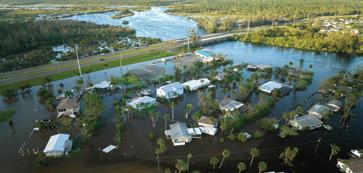
The Sea Level Solutions Center engages in local to global solutions-oriented research, education, strategic thinking, communications and outreach by organizing top scientists, educators, students, municipal leaders and policymakers to produce an accurate understanding of impacts of sea level rise and climate change for human and natural environments

Distinguished postdoctoral researcher Diego Cardeñosa co-created a portable, easy-to-use DNA testing toolkit that gives customs officials and inspection personnel the power to identify illegal species on-site and have proof to prosecute crimes. It’s helped stop illegal shipments of shark fins as well as European eels and South America’s matamata turtles.
The new Forensic Investigations Network in Digital Sciences (FINDS) Center of Excellence (COE) in digital forensics at FIU is a collaboration with Florida A&M, Grambling State University and Jackson State University. FINDS COE will provide training to a diverse student population and a workforce pathway for graduates entering the Department of Defense and other governmental agencies.
The Global Forensic and Justice Center’s Research Forensic Library is a first-of-its-kind resource for forensic science practitioners, students, researchers and the general public, providing access to thousands of articles and reports in the scientific literature.


FIU’s Health Disparities Initiative, funded by NIMHD and led by Mario de la Rosa and Andrés Gil, supports research and training in health disparities for the next generation of public health researchers and medical students.
A lack of diversity in clinical trials has cascading societal implications. FIU nurse scientist Trudy Gaillard leads a National Institute on Aging-funded study to understand how to boost older adult research participation The goal is to create an online statewide registry where diverse older adults can find clinical trials.

Childhood cancer patients tend to have limited access to precision medicine clinical trials and treatments that could potentially save their lives. Researcher Diana Azzam is identifying specific biomarkers among minority populations that can be targeted using FDA-approved drugs. Azzam is project lead on an NIMHD-funded study as part of the RCMI led by Eric Wagner to reduce health disparities in childhood cancer patients from minority populations.
The Research Center in a Minority Institution at FIU (FIU-RCMI), led by Eric Wagner, has received $33.4M over the past six years to support health disparities research on multiple diseases such as HIV, Alzheimer’s and childhood cancer.

Researchers Shanna Burke and Sabrina Sales Martinez are among the first to examine microbiota, metabolome, sleep, stress and cognition measures to identify early risk factors of Alzheimer’s disease linked to gut health.
The Center for Translational Science, under the leadership of Director Stephen Black, is an integral part of FIU’s efforts preparing the next generation of scientists and doctors through a robust focus on training doctoral students and postdoctoral fellows.

The FIU-FPL Solar Research Center is a solar research facility installed at FIU. The 1.4-megawatt solar array comprises more than 4,400 solar panels on canopy-like structures that provide clean energy to the grid. Faculty and students use the installation to conduct research that is helping FPL advance solar energy in the state.
Cardiovascular disease is the leading cause of death around the world. Research in the Hutcheson Cardiovascular Matrix Remodeling Lab focuses on the mechanisms through which tissues are built and maintained and the pathological changes that lead to disease. Researcher Josh Hutcheson and his team are looking at the development of vascular calcification in individuals with chronic kidney disease. They study the nanoscale events that result in formation of this mineral and investigate clinically approved drugs that may disrupt vascular calcification and improve quality of life for patients with chronic kidney disease.

Ph.D. candidate Valentina Dargam has developed an algorithm that can differentiate the sounds of a healthy heart from one that is developing disease. The concept is that using a digital stethoscope, detecting heart disease can come down to an algorithm. Dargam is currently testing the algorithm on mice to find proof that it works.
Arvind Agarwal and his research team have developed a new coating to protect machinery for use on the lunar surface against radiation levels up to 1,000 times greater than on Earth. A sample of the coating is heading to the International Space Station where it will be mounted outside the facility for exposure to space. The coating will then be analyzed for its resistance to radiation.

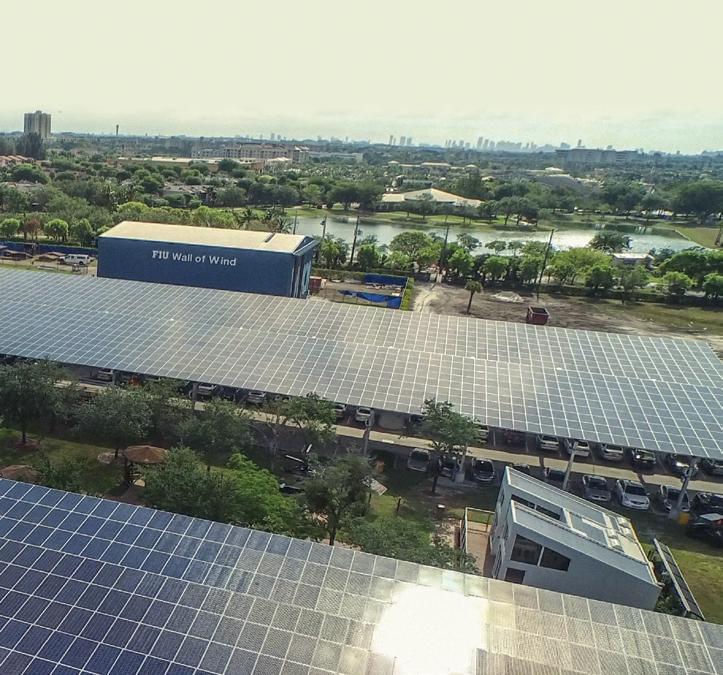

The Kimberly Green Latin American and Caribbean Center is designated by the U.S. Department of Education as a National Resource Center on Latin America, recognizing it as one of the top Latin American and Caribbean Centers in the country. The Title VI-funded center draws upon the expertise of one of the largest concentrations of Latin American and Caribbean Studies scholars of any university in the country.
Professors from FIU and the University of Puerto Rico, Mayagüez, are looking at the impact energy security has on vulnerable populations who rely on electrical power for medical equipment. The National Institutes of Healthfunded study aims to demonstrate the positive health impact of energy independence through direct access to solar power. The professors seek to provide an evidencebased model of how to get “off the grid” and establish best practices for this work. Puerto Rico faces frequent power outages due to damage to its power grid caused by natural disasters like 2017’s Hurricane Maria.
FIU and U.S. Southern Command have collaborated for more than a decade, resulting in hundreds of student internships and a partnership where faculty, staff and students conduct primary research on topics related to Latin American and Caribbean security. The research provides data and analytic power to support U.S. Department of Defense and partner-nation decision-makers with real-time information and analysis.
The U.S. Agency for International Development (USAID) has invested $105 million in FIU since 2004 — supporting global research in water sustainability, disaster-risk reduction, security and storm surge monitoring and warning in the Caribbean. As part of a recent agreement, the USAID will work with the Kimberly Green Latin American and Caribbean Center to increase research opportunities, internships and jobs for students.
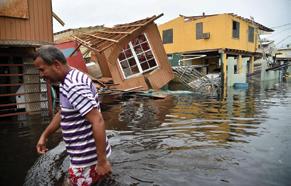


A new initiative funded by the National Science Foundation will engage undergraduate student leaders from the science, technology, engineering and math fields and incorporate them into university strategic and curriculum planning efforts. The student leaders will work in tandem with faculty and university leadership to transform the student experience for FIU’s STEM students.
49

For 16 years, FIU has partnered with the U.S. Department of Energy in a unique program of research and training the future STEM workforce for the Department of Energy’s Office of Environmental Management. 203 students have become DOE Fellows, with 98% of them entering the workforce.
FIU has more than 12,000 STEM students. The university is the nation’s largest producer of STEM degrees for Hispanics and ranks among the Top 10 in awarding bachelor’s degrees to African Americans.


